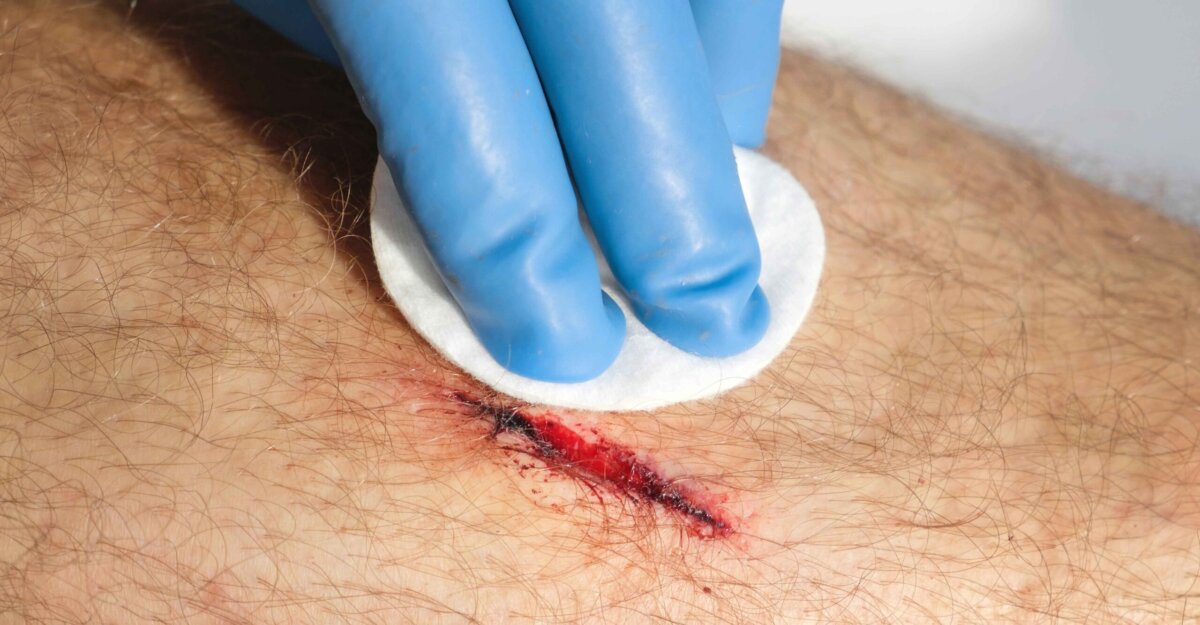Serosanguineous drainage is a normal response that shows a wound is healing effectively. But what else does it reveal?
One wound care expert shares the characteristics, concerns, and steps for proper management of serosanguineous drainage to help you better understand and care for this exudate type.
Defining serosanguineous drainage and what it reveals
Exudate from a wound that is a mixture of serous fluid which is a pale yellow color and sanguineous fluid which is bright red in color, is known as serosanguineous exudate, said Mudasser Javed, DPM, AACFAS, Co-Director of the Center for Hyperbaric Medicine and Wound Healing at St. Charles Hospital in Port Jefferson, New York.
At times, the presence of this exudate can be considered normal; however, it can also be abnormal (depending on the quantity).
“Scant to moderate amounts of serosanguineous drainage is expected from a healthy, healing wound,” said Javed.
But chronic wounds may also have this exudate which may occur in large or excessive quantities due to the chronic wound being stuck in the inflammatory phase of the healing process, he said.
Additionally, he added that excessive serosanguineous exudate may also be present in patients with draining wounds along with comorbidities such as venous insufficiency or lymphedema.
“Venous insufficiency and lymphedema are two conditions that cause increased swelling of the lower extremities,” Javed said. “The excessive interstitial fluid present with these two conditions drains through the tissue of the wound base, along with some sanguineous drainage from the granular wound base.”
Physical characteristics
To successfully identify serosanguineous, it’s important to understand the physical characteristics. According to Javed, they include:
- Color: There is a variation of color, from light pink to light red.
- Consistency: The consistency is watery/clear.
- Odor: Usually, no odor is present; however, serosanguineous exudate can become malodorous if it is sitting on the wound and not being absorbed by the dressing or if the dressing is kept intact for too long when excessive amounts are present.
Treatment goals and approaches
Javed said that the goal of treatment is to absorb the exudate and prevent it from sitting on the wound surface and surrounding skin.
“Excessive drainage that is not removed leads to a wound environment that is too moist, which can create maceration and damage to the tissue,” he said. “This can prolong the healing time.”
With that in mind, absorption can be achieved with certain wound care products. Some products can serve a dual purpose as they can absorb excess exudate and serve as an antimicrobial, he said. Iodosorb ointment is an example of this. According to Javed, because it contains iodine, this topical ointment can both absorb exudate and serve as an antimicrobial.
Other products commonly used are alginate and foam dressings which have increased absorption capacities compared to gauze, he added.
“If the alginate or foam contains silver, then it also provides antimicrobial properties.”
Interdry is another product that also contains silver. It is a moisture-wicking cloth that not only aids moisture control but also odor management, according to Javed.
“If edema of the surrounding tissues is contributing to the excessive drainage, then compression therapy dressings can also be applied to control the edema and reduce the amount of drainage,” he said.
If a lot of fluid is present, it’s important to change the dressings more frequently. An additional treatment Javed recommended is the application of a negative pressure wound vac therapy. This can help with exudate management.
Potential challenges
Javed said the main challenge when treating wounds with serosanguineous exudate is maintaining a proper level of absorption. Absorbing exudate from the wound reduces the moisture level of the wound environment.
“When serosanguineous drainage is absorbed well, it creates a better environment for healing,” he said.
While this exudate can be a normal occurrence in some wounds, it can also be a concerning symptom if seen in large quantities. By staying informed and proactive, you can manage this exudate and ensure the best possible outcome for your patients.
Take WCEI's engaging, evidence-based Wound Care Certification Courses. Choose the format that suits you and get access to tools to help you ace your exam.
Learn MoreWhat do you think?

